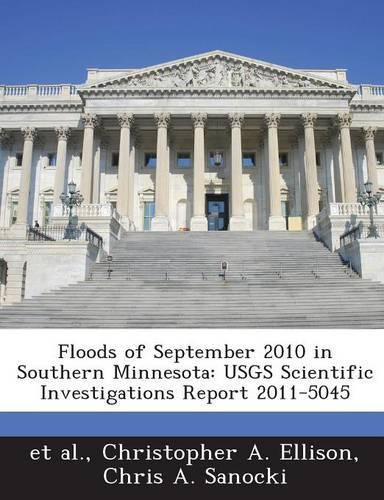Readings Newsletter
Become a Readings Member to make your shopping experience even easier.
Sign in or sign up for free!
You’re not far away from qualifying for FREE standard shipping within Australia
You’ve qualified for FREE standard shipping within Australia
The cart is loading…






During September 22-24, 2010, heavy rainfall ranging from 3 inches to more than 10 inches caused severe flooding across southern Minnesota. The floods were exacerbated by wet antecedent conditions, where summer rainfall totals were as high as 20 inches, exceeding the historical average by more than 4 inches. Widespread flooding that occurred as a result of the heavy rainfall caused evacuations of hundreds of residents, and damages in excess of 64 million dollars to residences, businesses, and infrastructure. In all, 21 counties in southern Minnesota were declared Federal disaster areas. Peak-of-record streamflows were recorded at nine U.S. Geological Survey and three Minnesota Department of Natural Resources streamgages as a result of the heavy rainfall. Flood-peak gage heights, peak streamflows, and annual exceedance probabilities were tabulated for 27 U.S. Geological Survey and 5 Minnesota Department of Natural Resources streamgages and 5 ungaged sites. Flood-peak streamflows in 2010 had annual exceedance probabilities estimated to be less than 0.2 percent (recurrence interval greater than 500 years) at 7 streamgages and less than 1 percent (recurrence interval greater than 100 years) at 5 streamgages and 4 ungaged sites. High-water marks were identified and tabulated for the most severely affected communities of Faribault along the Cannon and Straight Rivers, Owatonna along the Straight River and Maple Creek, Pine Island along the North Branch and Middle Fork Zumbro River, and Zumbro Falls along the Zumbro River. The nearby communities of Hammond, Henderson, Millville, Oronoco, Pipestone, and Rapidan also received extensive flooding and damage but were not surveyed for high-water marks. Flood-peak inundation maps and water-surface profiles for the four most severely affected communities were constructed in a geographic information system by combining high-water-mark data with the highest resolution digital elevation model data available. The flood maps and profiles show the extent and height of flooding through the communities and can be used for flood response and recovery efforts by local, county, State, and Federal agencies.
$9.00 standard shipping within Australia
FREE standard shipping within Australia for orders over $100.00
Express & International shipping calculated at checkout
During September 22-24, 2010, heavy rainfall ranging from 3 inches to more than 10 inches caused severe flooding across southern Minnesota. The floods were exacerbated by wet antecedent conditions, where summer rainfall totals were as high as 20 inches, exceeding the historical average by more than 4 inches. Widespread flooding that occurred as a result of the heavy rainfall caused evacuations of hundreds of residents, and damages in excess of 64 million dollars to residences, businesses, and infrastructure. In all, 21 counties in southern Minnesota were declared Federal disaster areas. Peak-of-record streamflows were recorded at nine U.S. Geological Survey and three Minnesota Department of Natural Resources streamgages as a result of the heavy rainfall. Flood-peak gage heights, peak streamflows, and annual exceedance probabilities were tabulated for 27 U.S. Geological Survey and 5 Minnesota Department of Natural Resources streamgages and 5 ungaged sites. Flood-peak streamflows in 2010 had annual exceedance probabilities estimated to be less than 0.2 percent (recurrence interval greater than 500 years) at 7 streamgages and less than 1 percent (recurrence interval greater than 100 years) at 5 streamgages and 4 ungaged sites. High-water marks were identified and tabulated for the most severely affected communities of Faribault along the Cannon and Straight Rivers, Owatonna along the Straight River and Maple Creek, Pine Island along the North Branch and Middle Fork Zumbro River, and Zumbro Falls along the Zumbro River. The nearby communities of Hammond, Henderson, Millville, Oronoco, Pipestone, and Rapidan also received extensive flooding and damage but were not surveyed for high-water marks. Flood-peak inundation maps and water-surface profiles for the four most severely affected communities were constructed in a geographic information system by combining high-water-mark data with the highest resolution digital elevation model data available. The flood maps and profiles show the extent and height of flooding through the communities and can be used for flood response and recovery efforts by local, county, State, and Federal agencies.